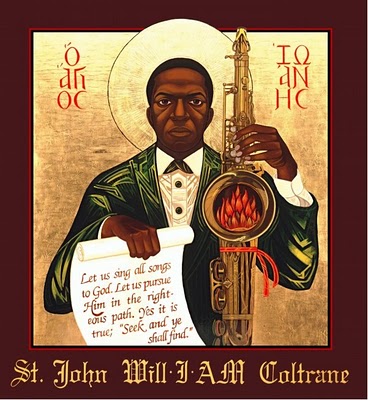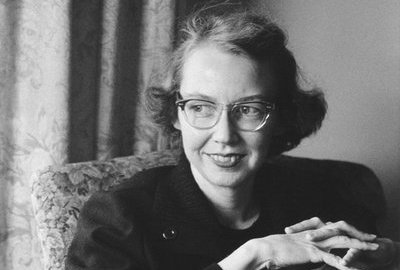I never, until this week, made the explicit connection between John Coltrane and Flannery O’Connor.
And why should I have?
One was an introverted white woman, a southern writer who tackled the Big Questions with a mordant elan and irony that has never been surpassed. In her short stories, the themes of identity, religion and salvation are interrogated by and through a series of characters who are, by turns, innocent, evil and grotesque. Above all, they are fallible: whatever their station in life, the issue that obsessed O’Connor was Grace and whether or not we could get good with God, regardless of where He placed us or what He put in our pathway.
The other was a quiet but prolific black saxophonist, a man born in North Carolina who migrated to the cultural center of the musical universe, New York City, where he participated in some of the most beloved recordings of the ’50s and ’60s. In his songs, the quest was salvation through music: initially celebrated for his famous “sheets of sound”, Coltrane continued to expand and grow, incorporating Eastern elements and extended improvisations. His live performances became legendary endurance tests, for the audience more than the performer. Coltrane was restless, but not because he was otherwise preoccupied or tortured; indeed he was the rarest of artistic breeds: focused and serene, uncomfortable only when he was unable to practice. By all accounts, his dedication to his craft remains unrivaled.
How could I not have made the connection?
Fortuitously, I came upon two pieces this week, one a new review (of O’Connor and her work), the other an old interview (with Rashied Ali, who played with Coltrane in the last years of his life). Reading them side by side, I was struck by one thing above all: these were artists who, due to circumstances as well as compulsion(s), cultivated an almost monastic approach to their art. Perhaps because illness claimed both of them entirely too soon (Coltrane died of cancer in ’67, aged 41; O’Connor of lupus in ’64, aged 39) there is a kinship forged in tragedy. Perhaps because they are both undisputed masters of their respective crafts who lived during roughly the same era it’s easier to associate them. But it is their aesthetic approach that links them in ways few other artists of any genre can claim.
James Parker’s excellent piece in The Atlantic discusses A Prayer Journal, “the contents of a devotional notebook that O’Connor—a turbocharged Catholic—kept from January 1946 to September 1947, while she was a student at the Iowa Writers’ Workshop.”
Money quote: On the surface, as O’Connor’s biographer, Brad Gooch, tells it in Flannery, she was a quiet but significant classroom presence: “She scared the boys to death with her irony,” remembered one visiting lecturer, Andrew Lytle. Beneath the surface, as recorded on the 47 and a half handwritten pages to which we now have access (A Prayer Journal includes a facsimile), she was refining her vocation with the muscularity and spiritual ferocity of a young saint-in-waiting. The first page or pages of the notebook have been lost, and it begins—how poetic is this?—mid-sentence, with “effort at artistry.”
O’connor’s unwavering allegiance to her craft leaves little to the imagination: she wrote, she talked about writing, she thought about writing and she wrote about writing. Allegedly, she ate and slept on occasion. “In my stories is where I live,” she said, a statement applicable on a variety of levels. And so, the people who stand to be fascinated by this distinctly uneventful life are the very people who might be enlightened by reading about it: writers. O’Connor’s life, and her monk-like approach to her vocation could and should be a study guide for all aspiring scribblers. Never mind that dedication like hers is probably impossible to imitate today because of all the noise, electronic and digital, distracting us. There is also the inconsiderable reality that her work is inimitable. The style, the substance, the entire package is pretty much unparalleled in American letters.
I tend to feel uncomfortable throwing the G word around, unless I’m speaking about jazz musicians. But if any writer in the last 100 years could be called a genius, O’Connor is near the top of the short list. She did not manage to write the great American novel (though she may well have, had she been given even a few more years), but her best collected stories go toe-to-toe with any of the great white males (and females for that matter). She also happened to approach perfection on at least three occasions, with “Revelation”, “Everything That Rises Must Converge” and “A Good Man Is Hard To Find”. It is the last of these three that most people know; like Beethoven’s Fifth and the ceiling of the Sistine Chapel, its ubiquity tends to diminish its actual import: it’s even better than most people realize (and most people, if for no other reason than that they are told, recognize these things as immortal).
What O’Connor manages to do, in less than twenty pages, is nail the essence of what Dostoyevsky and, to a lesser extent, Tolstoy grappled with in their biggest (and sometimes bloated) novels: the nature of man, the existence of God, the possibility of Grace and the symbiotic tension between violence and love. When The Misfit declares (ironically, truthfully) “It’s no real pleasure in life”, he is (O’Connor is) expressing, in remarkably succinct fashion, the fundamental philosophical and literary dilemma, post-Descartes. Beyond whether God exists (Tolstoy) or why God torments us (Dostoyevsky), and right to the heart of the matter: we may betray God, but God betrayed us first.
Anyway, O’Connor remains somewhat of a conundrum: one can learn a great deal by studying her stories. Has any other writer so consistently applied mechanical precision with such emotional heft? Has any other writer wrestled with the so-called big issues without using stick figures or preachy didactics? Take “Revelation”, for instance: O’Connor fits class issues, southern identity dilemmas, religious fervor, old-school bigotry and redemption into one story. In fact, she pretty much pulls it off on a single page (and that last page not only invokes, but obliges the use of such otherwise unforgivable words as “haunting”, “chilling” and “moving”). This type of writing, needless to say, is inspiring but is also intimidating. My initial (and in many cases, ongoing) reaction to reading an O’Connor story is to ask, in awe, “How did she do that?”
Yet aside from the singular example she sets, what is one, living today, to take from her hermetic life style in terms of practical application? Probably the same thing one might take from any worthwhile practitioner: whatever one can. It’s that simple, and it’s that unfathomable. For starters, one should be heartened (or, more likely, devastated) by the fact that even our greatest artists often struggle, and realize that the life they embark upon is likely to be painful and unprofitable. “What first stuns the young writer emerging from college,” she wrote in 1948, “is that there is no clear-cut road for him to travel on. He must chop a path in the wilderness of his own soul; a disheartening process, lifelong and lonesome.” What she said.
For those whose definition of genius is either too encompassing or excessively narrow, John Coltrane poses no problems: there isn’t anyone who knows anything about music (in general) and jazz (in particular) who would contest that he is among the most prominent, impressive and influential artists to ever master an instrument. Furthermore, to put Coltrane and his unsurpassed proficiency in its simplest perspective, it might be suggested that no one has ever done anything as well as Coltrane played the saxophone. Plus, he was an exceptionally gifted composer and bandleader and, by all accounts, he was a generous and gentle human being, as well. All of which is to say, if there is anyone worthy of celebration in our contemporary American Idol Apocalypse, Coltrane should serve as both antidote and inspiration.
Here is the interview with Rashied Ali, conducted by Howard Mandel. It is well-worth reading in full, but here are some key quotes:
He never stopped playing. When I used to go to hear ‘Trane, he would always be playing. He would be playing in his dressing room. He would be playing before he got to me. Just like a fighter would warm up in the dressing room, he’d come out in the ring and he’d be sweating from warming up, he would do the same thing in the dressing room. He would just play and play and play. He would break a sweat in the dressing room and then when he would come out on the bandstand, he had all that — I don’t know where he got that energy from. He was relentless.
He always had an instrument in his hand. He was always playing something. He was always trying to be better than he was and it seemed like, you know, how could he get better? How could he do anything better than that, than what he’s done already? And after playing all these years with all these different people…the man still had a vision that he could be better than he was and he was still practicing. You know, after awhile you stop practicing. This man was in his 40s, right? And he had played with everybody and he was still playing everyday. So that was a profound statement as far as I was concerned.
Of course, Coltrane’s music was not universally embraced during the final years he was able to record and play. His solos became longer and (much) more intense, yet no matter how many listeners he alienated, it was apparent that in order to push the audience, he first had to push himself. Roscoe Mitchell, commenting on this spiritual searching, likens Coltrane’s later music to what he witnessed in churches growing up, with people transporting into religious trances. This—the music and the explanation—is where more than a few draw the line; it’s just too out there.
Coltrane knew where he was going, however, even if he could not quite define what he was looking for. His wife Alice remarks that Coltrane was following a “progression toward higher spiritual realization…and development.” That type of sentiment can, and perhaps should, make people wary (this being the ‘60s, etc.) but with Coltrane it was no pose, and this was no joke. Not for nothing is A Love Supreme considered one of the most important, and affecting, albums in all of jazz. And later, even amidst the sonic uproar, came majestic and tranquil offerings like “Dear Lord” and “To Be”.
It was all over far too quickly. As is too often the case with our greatest artists, Coltrane fell ill and passed away long before his time should have come. It scarcely computes, even now, that the man making the music he recorded in early 1967 (particularly the shattering if cathartic Interstellar Space) was months from losing a battle with cancer. Where he would have headed had he lived is truly difficult to imagine. It remains instructive, and more than a little startling, to consider the growth and refinement he demonstrated every few years, commencing in the mid-to-late ‘50s. Where he might have gone next is anyone’s guess, but it’s also safe to surmise that he took his instrument, and music, as far as anyone possibly could.


